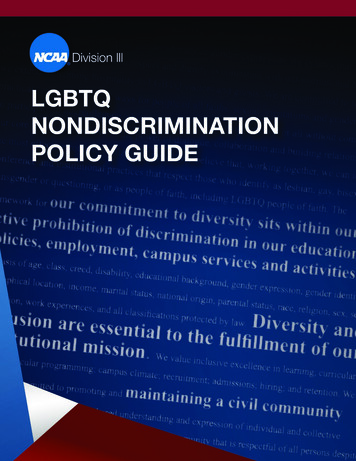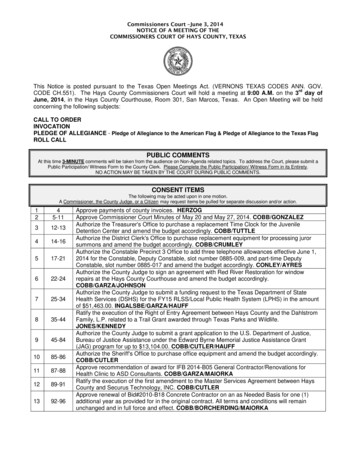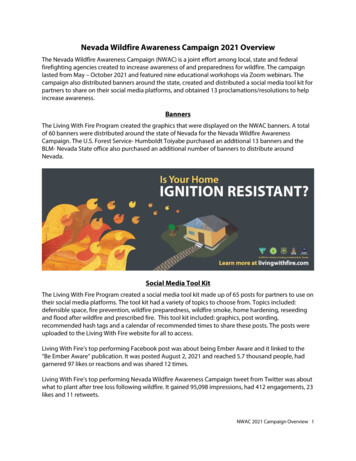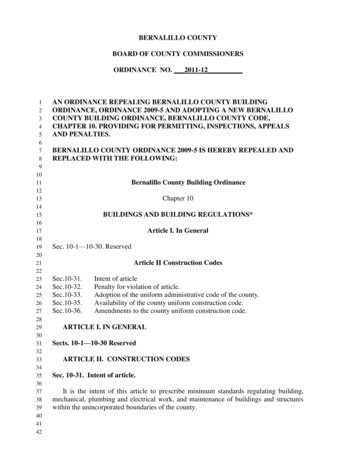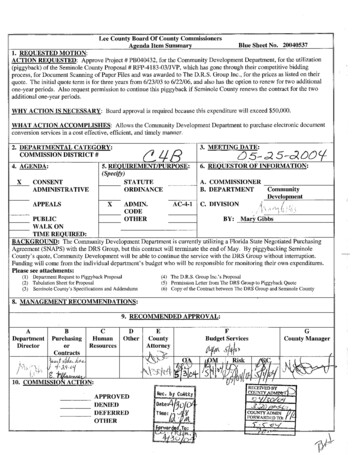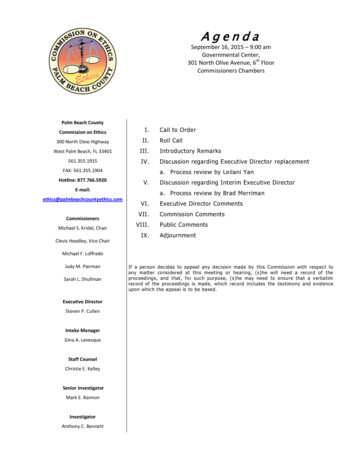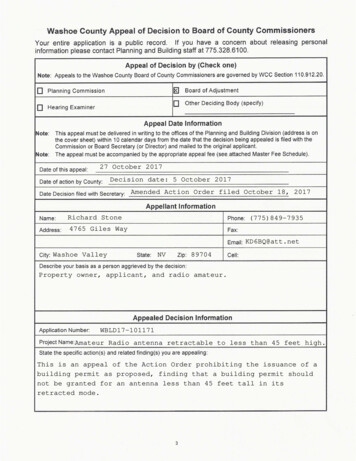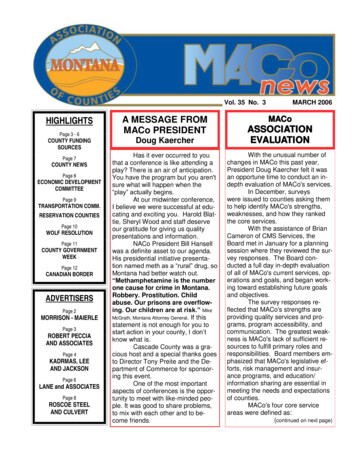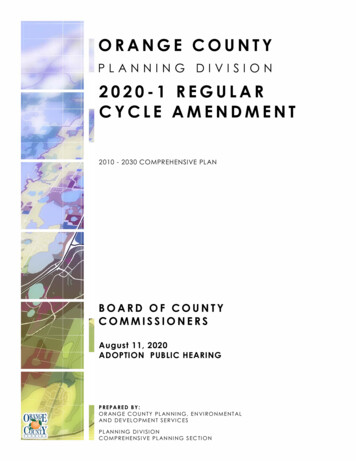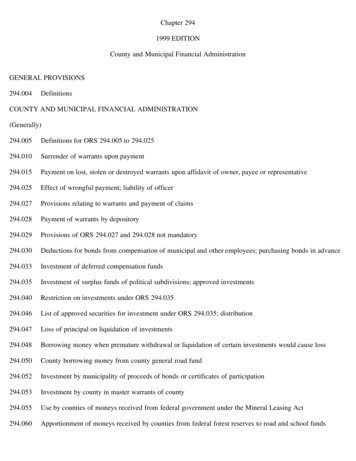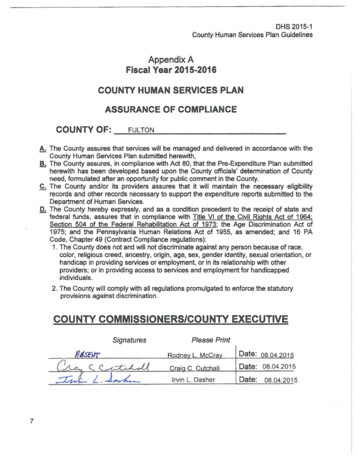
Transcription
OHS 2015-1County Human Services Plan GuidelinesAppendix AFiscal Year 2015-2016COUNTY HUMAN SERVICES PLANASSURANCE OF COMPLIANCEFULTONA. The County assures that services will be managed and delivered in accordance with theCounty Human Services Plan submitted herewith,B. The County assures, in compliance with Act 80, that the Pre-Expenditure Plan submittedherewith has been developed based upon the County officials' determination of Countyneed, formulated after an opportunity for public comment in the County.C. The County and/or its providers assures that it will maintain the necessary eligibilityrecords and other records necessary to support the expenditure reports submitted to theDepartment of Human Services.D. The County hereby expressly, and as a condition precedent to the receipt of state andfederal funds, assures that in compliance with Title VI of the Civil Rights Act of 1964;Section 504 of the Federal Rehabilitation Act of 1973; the Age Discrimination Act of1975; and the Pennsylvania Human Relations Act of 1955, as amended; and 16 PACode, Chapter 49 (Contract Compliance regulations):1. The County does not and will not discriminate against any person because of race,color, religious creed, ancestry, origin, age, sex, gender identity, sexual orientation, orhandicap in providing services or employment, or in its relationship with otherproviders; or in providing access to services and employment for handicappedindividuals.2. The County will comply with all regulations promulgated to enforce the statutoryprovisions against discrimination.COUNTY COMMISSIONERS/COUNTY EXECUTIVESignaturesPlease PrintRodne L. McCraCraiIrvin L. Dasher7Date: 08.04.2015Date: 08.04.2015Date: 08 .04.2015
DHS Bulletin 2015-1County Human Services Plan GuidelinesAppendix BCounty Human Services Plan TemplateThe County Human Services Plan is to be submitted using the Template outlined below. It is tobe submitted in conjunction with Appendices A and C (C-1 or C-2, as applicable) to theDepartment of Human Services (DHS) as directed in the Bulletin.PART I: COUNTY PLANNING PROCESSDescribe the county planning and leadership team and the process utilized to develop the planfor the expenditure of human services funds. Counties should clearly identify:1. Critical stakeholder groups including individuals and their families, consumer groups,providers of human services, and partners from other systems;The Fulton County Commissioners formed a human services planning team in June, 2012 inorder to explore opportunities that might arise from piloting the block grant. It was decided atthat time that there likely would not be enough time to put together a plan in the first twoyears that would look a whole lot different from current plans. Also, with the state cuts inbudgets, it was also felt that cutting those programs additionally would be detrimental toconsumers. Therefore the initial planning team was composed largely of those personsrepresenting agencies currently receiving funding. Through the years, it has grown to bedeliberately more inclusive and team members now look more at outcomes and makedecisions based more on outcomes than on specific allocations.The planning team named for the 2015-16 year includes:NAME1. Anne Harvey2. April Rouzer3. Barry Munch4. Carrie Gray5. Craig Cutchall6. Doug Tengler7. Elen Ott8. Irvin Dasher9. Jean Snyder10. Julie Dovey11. Richard Wynn12. Rodney McCray13. Shalom Black14. Sr. Margie Monahan15. Skip Ramsey16. Steve Nevada17. Wendy MeliusREPRESENTINGArea Agency on AgingFranklin/Fulton Drug & Alcohol DirectorMHA Assoc. of Franklin/Fulton (consumer rep)Franklin County Assistant AdministratorFulton County Commissioner (non-voting)Fulton County Chief Financial OfficerFulton County Family Partnership, Inc.Fulton County Commissioner (non-voting)Fulton County Human Services AdministratorFulton County Family Partnership, Inc.Franklin County Human Services Admin.Fulton County Commissioner (non-voting)Franklin County Grants PlanningFulton County Catholic MissionConsumer RepFranklin/Fulton MH/ID AdministratorCenter for Community ActionIt should be noted that the Fulton County Human Services administrator serves on the Franklin8
DHS Bulletin 2015-1County Human Services Plan GuidelinesCounty planning team and the Franklin County Human Services Administrator serves on theFulton County planning team in order to better facilitate cross-systems planning. Although theabove team represents the “working” team with regard to the 2015-16 plan, other groupsinvolved in the process include:1) Fulton County Housing Committee – consists of 15 members including managers of localhousing for the elderly, mentally ill and low-income families. This committee has provider andconsumer participation. (Meets quarterly)2) Fulton County Family Partnership – consists of more than 50 partners who representother agencies, non-profits, churches and consumers. This is the 501 3 which provideshuman services planning for the county. It is composed of providers, consumerrepresentatives, clergy, business and other community individuals who seek membership.(Meets monthly)3) Fulton County Services for Children Advisory Board – includes 15 members includingthree student members. (Meets 6 times/year)4) Victims of Crime Act (VOCA) Funding Committee – includes 15 members who makefunding decisions regarding VOCA funds used for domestic violence programs. (Meets 2times per year)5) Family Engagement Committee – this is a sub-committee of the local Franklin/FultonChildren’s Roundtable. It consists of 14 members and meets quarterly.2. How these stakeholders were provided with an opportunity for participation in theplanning process, including information on outreach and engagement;This team is currently responsible for developing the plan for the expenditure of humanservices funds for the 2014-15 fiscal year. The committee is also charged withconsidering the various reallocation of funds throughout the year and that is done through anapplication process that has been developed. The planning team met on the following dateswith agenda items in parentheses: May 30, 2014 (Consumer Involvement, final vote on unspent 13-14 funds, Dis cussion of 14-15 plan and planning process, review of planning guidelines, publichearing dates, outcomes). 12 in attendance. July 24, 2014 (Final 13-14 expenditure report, outcomes, consumer involvement,13-14, reconciliation with Franklin County, discussion of final 14-15 HSBG planand review, public hearing attendance and possible expansion of the HSBGPlanning Team. 13 in attendance October 30, 2014 (match, carryover, individual requests for unspent funds,financial position at the ¼ year) 14 in attendance January 29, 2015 (Financial position at the ½ year, discussion of carryover andfunds given for reallocation, discussion of four applications for unspent funds, voteon recommendations to be sent to Commissioners, demonstration of ORS(outcomes system). 14 in attendance. April 30, 2015 (Membership, financial position at the ¾ year, decision onreallocation funding recommendations, upcoming CCAP Block Grant meeting on5/6/2015). 12 in attendance. June 2, 2015 – (Review of financial position, requests for funding remaining, 2015 16 guidelines and plan submission/assignments, public hearings dates set,outcomes and report from CCAP block grant meeting.) 15 in attendance.9
DHS Bulletin 2015-1County Human Services Plan GuidelinesOther boards and committees (outside of the Planning Committee) such as those outlinedabove are informed of block grant activities as a block grant agenda item when meetingsare held. All were invited to the public hearings.3. How the county intends to use funds to provide services to its residents in the leastrestrictive setting appropriate to their needs. For those counties participating in theCounty Human Services Block Grant, funding can be shifted between categorical areasbased on the determination of local need and within the parameters established for the BlockGrant;The flexibility of the block grant allows counties to serve consumers in the least restrictivesetting. It is now possible to assess and address need(s) at the local level and to provide thesupports that are necessary for all consumers – aging, adult, children as well as those withmental health, intellectual disability and drug and alcohol challenges to be served in thecommunity. One of the outcomes that is measured in many of the funding streams is how manyare served in their own home (as opposed to residential facilities), how many placements ofchildren were prevented and other outcomes which are currently being identified. For the ChildWelfare Special Grants, outcomes reports are submitted for the FGDM and the Alternatives toTruancy programs. Another outcome of particular value to us this year was the ability to raisethe funding level for Homeless Assistance so that our waiting list could be cleared. In addition,we are often more able to provide more needed funds for Drug & Alcohol treatment.4. Substantial programmatic and/or funding changes being made as a result of last year’soutcomes. – Nothing substantial at this time.PART II: PUBLIC HEARING NOTICETwo (2) public hearings are required for counties participating in the Human Services BlockGrant. One (1) public hearing is required for counties not participating in the Human ServicesBlock Grant.Please provide the following:1. Proof of publication; (Please see Appendix F)2. Actual date(s) of public hearing(s);June 16, 2015 – 1:00 p.m. at Fulton Theater, McConnellsburg, Pa.June 23, 2015 - 1:30 p.m. in the Services for Children conference room3. A summary and/or sign-in sheet of each public hearing. (Please see Appendix G)PART III: WAIVER REQUEST(applicable only to Block Grant Counties)If you are requesting a waiver from the 25% minimum expenditure level for any categorical area,please provide justification for the request. The justification must show that specificcircumstances in the county create a local need for services that cannot be met without awaiver, and that adequate and appropriate access to other human services will be available in10
DHS Bulletin 2015-1County Human Services Plan Guidelinesthe county. It must also specify the amount of funds and the human services on which thosefunds will be transferred and expended. No waiver requested.PART IV: HUMAN SERVICES NARRATIVEMENTAL HEALTH SERVICESThe discussions in this section should take into account supports and services funded (or to befunded) with all available funding sources, including state allocations, county funds, federalgrants, HealthChoices, reinvestment funds, etc.a) Program Highlights:Highlight the achievements and other programmatic improvements that have enhanced thebehavioral health service system.The Franklin/ Fulton County Mental Health Program provides services to Franklin/ FultonCounty adults with severe and persistent mental illness and children who have a mental healthdiagnosis or who are at risk of developing a mental illness.Through contracted case management, our agency provides intake, assessment, andcoordination of the following services: outpatient psychotherapy, psychiatric and psychologicalevaluation, medication monitoring, residential programs, vocational and social rehabilitation,short-term inpatient, partial hospitalization and 24- hour emergency services.The following list describes program achievements and improvements:Crisis Intervention Team (CIT) – This initiative is in its third year and continuing to gainmomentum. The team is now 41 strong with members representing law enforcement, firstresponders, crisis, 911 dispatchers, jail officers/staff, probation officers, mental healthprofessionals and advocates. South Central Region CIT continues to follow the fidelity of the Memphis Model of CIT.During the 40 hours of training, we are fortunate to have a certified trainer for theVeterans module. Outcomes: We are tracking the number of personnel trained and their disciplines. Weare currently working with Shippensburg University to complete research and datacollection relating to the number of mental distress calls received by 911.o To date we have held three CIT trainings and have forty one members withnineteen of them representing law enforcement:11
DHS Bulletin 2015-1County Human Services Plan nt46%Mental Health32%FirstResponders7%According to the pre/post test data, knowledge of each core topic was increased a pointor a point and half after the CIT training:6543Pre Test 14-Oct2Pre Test 14-Feb1Pre Test 15-May0Post Test 14-OctPost Test 14-FebPost Test 15-May12
DHS Bulletin 2015-1County Human Services Plan GuidelinesQPR QPR stands for Question, Persuade and Refer, three steps anyone can learn to help preventsuicide. Just like CPR, QPR is an emergency response to someone in crisis and can save lives.(QPR Institute)We have been offering this training since 2007 and currently have over 300 people trained inFulton County. This includes all three school districts, government staff, and human serviceagencies.Mental Health First Aid Continues to be available in the community for those requesting the training. Currently, we havetrained community members to include corrections, business, and human services.Supportive Employment Continue to work towards increasing our supported employment opportunities for those inthe workforce.Outcomes: We tracked the number of employees engaged in Supportive Employmentand the percent change compared to last year. FY 14-15 doesn’t include individuals whoare transitioning into supported employment and we are still trending towards 4%Change12-13 to13-14FiscalYear14-15%Change13-14 otal668325.8%9413.3%*14-15 is completed through AprWRAP WRAP Education continues to grow in our community. Currently, we have had 48 people whohave completed level 1 WRAP and 290 that have attended an overview session learning aboutWRAP. Please refer to the collaboration section of the intellectual disabilities narrative for moreinformation.13
DHS Bulletin 2015-1County Human Services Plan GuidelinesSystem Service NeedsIn a review of system service needs, MH/ID/EI recognized that historically, our system hasrequired improvements in data collection related to quality of care. In response, MH/ID/EIpartnered with other entities in our community to identify which areas should be analyzed for oursystem. We created workgroups and assigned them to priority areas for system indicatorsanalysis. The following topics arose as needing improvement; we detail what has been donesince last year to improve these areas.Readmission rates We continue to have a workgroup comprised of outpatient providers, behavioral healthunit, advocates, crisis, case management, HealthChoices, managed care, and thecounty. The group is focused on identifying any commonalities and discrepancies in ourservices compared to neighboring communities. The information will be combined withresults of a survey from individuals that have experienced multiple admissions with thegoal of creating an action plan.Outcomes: We tracked the annual readmission rates and the percent change comparedto previous years. From 2012 to 2013, there was a significant decrease across the boardin admissions, readmissions, and bed days. Our decline in bed days continuedthroughout 2014. These numbers do not represent the whole county but those that werereported to MH/ID office.Fulton Hospital Data% Change2011 2012 2013 (12 - Readmission373-57%0-100%172212164-23%24-85%Bed Days14% Change2014 (13 - 14)
DHS Bulletin 2015-1County Human Services Plan Guidelinesb) Strengths and Needs:Please identify the strengths and needs for the following target populations served by thebehavioral health system: Older Adults (ages 60 and above) Strengths:o Scheduled to meet with the local nursing home and home health providers’continuum of care committee to determine how to partner and become activemembers within each other’s service system.o Continue to provide training regarding older adults and mental health to lawenforcement and first responders through CIT program. This includes best wayto intervene and resources available.o Senior Reach provided by Mental Health Association serves older adults bycalling them on the phone bi-weekly to check in and see how they are doingand if they are in need of anything. Adults (ages 18 and above) Strengths:o Community Support Program continues to support the community by hostingWalk the Walk that had over 100 participates last October.o Outpatient groups are available in the local outpatient provider. Needs:o To provide outreach services in peoples’ homes whereby a team composed ofaging and mental health (and potentially nursing) staff would provideassessment and resource-sharing services to older adults to address quality oflife issues.Needs:o More opportunities for competitive employment for individuals.Transition-age Youth (ages 18-26) Strengths:o The focus is on employment opportunities and skills training for transition-ageyouth. We are offering education sessions to the families and support systemso they are also aware of what is available in our community. Needs:o Employment and housing options are needed in our community for transition-ageyouth.o Independent living skills training is needed for this population. General activities ofdaily living such as balancing a check book, paying bills, grocery shopping,cooking, and cleaning are some examples.15
DHS Bulletin 2015-1County Human Services Plan Guidelines Children (under 18). Counties are encouraged to also include services like StudentAssistance Program (SAP), Respite, and CASSP Coordinator Services and Supports inthe discussion. Strengths:o Kick-off Your Drug Free Summer will continue this year and has proved successfulnot only with the amount of participation but in the fact the communities havetaken over the program and now we are a partner instead of the organizero Children and Adolescent Service System Program (CASSP): We tracked thenumber of families and schools accessing service and supports:Fulton CASSPCalendar year2012 2013Meetings Held5938New Referrals43Higher level of care 21*2015 is current through May2014474020151600o The provision of school-based mental health services to all secondary schools inFulton County.o The provision of the Student Assistance Program (SAP) in all of the secondaryschools in Franklin and Fulton Counties.SAP Screening info# students screened2013-14 (thru Apr) 382012-2013272011-201241% MH87%89%85%% D&A0%0%2%% CO13%11%12% Needs:o It appears that CASSP referrals have decreased in the county.o Funding to provide SAP within the elementary schools in our county.Identify the strengths and needs for the following special/underserved populations. If the countydoes not serve a particular population, please indicate. Individuals transitioning out of state hospitalsStrengths:o Fulton County continues to partner with the state hospital to create a communitysupport plan with input from the individual, their treatment team and family/friends.Prior to discharge, this plan is reviewed again by the same group and follows theperson into the community.Needs:16
DHS Bulletin 2015-1County Human Services Plan Guidelineso There is a committee currently working to identify needs and makerecommendations to decrease the number of hospitalizations.o There appears to be a need for more supported housing to assist in the transitionsand also to provide some diversion from needing higher levels of care. Co-occurring Mental Health/Substance AbuseStrengths:o The Implementation committee created a co-occurring credentialing process forproviders. It is mirrored from the OMHSAS bulletin that was created. In June,Franklin/Fulton MH/ID and HealthChoices will begin to credential those outpatientproviders that want to be recognized as a credentialed provider. Please refer tothe transformation priorities for further detail.o Training related to co-occurring illness continues to be offered free to ourproviders.Needs:o Financial support is needed to afford clinicians the time to prepare for andcomplete the Certified Co-Occurring Disorders Professional (CCDP) credential. Justice-involved individualsStrengths:o There are health navigators that work at the Franklin County Jail to assist inmatesin completing insurance applications and applying for any other financial resourcesthey may be eligible for upon release. This assists them in re-entry to thecommunity.o Also refer to the CIT update in program highlights.o Franklin-Fulton MH/ID/EI, TMCA HealthChoices, and the Franklin County Jailcompleted a study of our local jail population. The results indicate that most of theinmates were not involved with the mental health system prior to entry in the jail.Needs:o Early identification and assessment of individuals with MH issues who becomeinvolved in the criminal justice system.o A facility that would be available 24/7 to provide assessments for individuals thatdo not need to go to jail but need some support or diversion. Veterans:Strengths:o During the week of CIT training, law enforcement is continuing to be educatedabout experiences of Veterans returning home after combat.Needs:o A method of better engagement is needed. Stigma also seems to play a role inlack of access.17
DHS Bulletin 2015-1County Human Services Plan Guidelines sex (LGBTQI) consumersStrengths:o Through CIT, Law Enforcement is being educated about experiences of personsidentifying as belonging to the transgender culture.Needs:o List of local MH providers trained to understand the needs of LGBTQI consumers Racial/Ethnic/Linguistic minoritiesStrengths:o MH/ID/EI does have a contractual agreement with an agency which providestranslation and interpretation services. Many of our brochures are both Spanish aswell as English.Needs: None identified. Other, if any (please specify)Strengths: None identifiedNeeds:None identifiedc) Recovery-Oriented Systems Transformation:Describe the recovery-oriented systems transformation efforts the county plans to initiate in thecurrent year to address concerns and needs.For each transformation priority, provide: A brief narrative description of the priorityA time line to accomplish the transformation prioritiesInformation on the fiscal and other resources needed to implement the priorities (howmuch the county plans to utilize from state allocations, county funds, grants,HealthChoices, reinvestment funds, etc., and any non-financial resources).A plan/mechanism for tracking implementation of priorities.TRANFORMATION PRIORITY1 Comprehensive, Continuous, Integrated System of Care Model implementation (CCISC) todevelop a service system that is co-occurring capable.2 Transition age and forensic population housing option to assist entry into the adult systemand re-entry to the community from incarceration. It will offer supports for successfultransition to independent living.3 Public Awareness Campaign to assist the community in understanding mental health andsubstance use disorder and how to access services.4 Increase integration between mental health and the aging population.5 Data collection to increase knowledge of quality of services in order to assist in making betterdecisions for service delivery.18
DHS Bulletin 2015-1County Human Services Plan Guidelines1. Comprehensive, Continuous, Integrated System of Care Model implementation (CCISC) todevelop a service system that is co-occurring capable.i. Implementation team is working on a credentialing process to recognize localproviders that have completed the criteria to be co-occurring capable.1. The certification program is scheduled to begin the process in May 2015with the outpatient providers interested in becoming a recognized countycertified co-occurring program. The completion date target is Dec 2015. Atwo percent incentive rate has been established to encourage participationin the program. Healthchoices funds have been utilized to assist withtraining elements of the program. This is monitored through the CCISCaction plan and reviewed at implementation team meetings. In addition thismonitored during Healthchoices monthly Quality Improvement/UtilizationManagement meetings.2. June 19, 2015 we are hosting a Networking Day just for providers. Thegoal is to foster the relationships between community providers andincrease their knowledge of each other’s specialties to allow for betterreferrals.ii. Change Agent Committee continues to meet on a quarterly basis. Researchingevidence based programs that focus on the co-occurring population and will thenmake a recommendation to providers to begin use if possible. The targetedcompletion date isJan 2016. Once an assessment tool is identified funds of 500may be needed to provide training. This is monitored through the CCISC actionplan and reviewed at implementation team meetings. In addition this is monitoredduring Healthchoices monthly Quality Improvement/Utilization Managementmeetings.2.Public Awareness Campaign to assist the community in understanding mental health andsubstance use disorder and how to access services.i.ii.iii.iv.v.I Am the Evidence awareness campaign through the PA Mental Health AssociationHealth Fairs, Job FairsEmail blastsChamber of CommerceCommunity Events1. As of June 30 2015, Mental Health will have participated in over 30community events of various audiences. The goal of community events isto provide education about mental wellness. Target completion date –isJune 2016. Funds and staff time will be provider through the mentalhealth program to support this effort. This is being monitored throughMental Health staff meetings. Updates regarding outreach are submitted toOMHSAS.3. Increase integration between mental health and the aging population.i. CIT continues to be an avenue for law enforcement to learn strategies to relate tothe older adults. Targeted completion date is June 2016. Ongoing training is19
DHS Bulletin 2015-1County Human Services Plan Guidelinespending State funds being released. This is monitored through Criminal JusticeAdvisory Board Behavioral Health Sub-Committee.ii. JOACT – (Joint Older Adult Crisis Team) – A collaboration of Mental Health andArea Agency Aging responding with mobile crisis to older adults. Targetedcompletion date is June 2016 Research is being done in regards to fiscal costs asprogram is in development. Once cost analysis is completed funding availabilitywill be reviewed to support the program.4. Data collection to increase knowledge of quality of services in order to assist in making betterdecisions for service delivery.i. Working with the providers to gather data that is comparable among the similarservices and determine if those receiving services are satisfied.ii. Created a spreadsheet of all provider goals and progress updates. Targtedcompletion date is August 2015iii. Create a spreadsheet listing trackable data that is currently available in ourcomputer system. Targted completion date is Oct 2015iv. Research is being conducted regarding possible data warehouse system that canbe utilized by provider and county staff to monitor, collect, and analyze data.Based on outcome of research costs will be analyzed in relation to availablefunding. Targted completion date is June 2016 . This is being monitored as part ofthe Mental Health Staff meeting.*On a quarterly basis progress on each of the transformation priorities is reported to our CommunitySupport Program.INTELLECTUAL DISABILITY SERVICESDescribe the continuum of services to enrolled individuals with an intellectual disability within thecounty. For the narrative portion, please include the strategies that will be utilized for allindividuals registered with the county, regardless of the funding stream. For the chart below,regarding estimated numbers of individuals, please include only those individuals for whombase or block grant funds have or will be expended. Appendix C should reflect only base orblock grant funds except for the Administration category. Administrative expenditures should beincluded for both base/block grant and waiver administrative funds.It is the mission of Franklin/Fulton Mental Health/Intellectual Disabilities/ Early Intervention thatFranklin/ Fulton Mental Health/ Intellectual Disabilities/ Early Intervention partners with thecommunity to develop and assure the availability of quality MH/ID/EI services and supports forindividuals and families. Through the use of a person-centered planning approach and theutilization of Prioritization of Urgency of Need for Services (PUNS), the ID program assistsindividuals in accessing services and supports within their community regardless of the fundingstream. The PUNS gathers information from the person-centered planning approach to identifycurrent and anticipated needs. This information allows Franklin/Fulton Mental Health/IntellectualDisabilities/Early Intervention to budget and plan for the continuum of services and to developprograms to meet the needs of the community. Programs support client engagement andprovide access to services for employment, training, housing and family support as appropriate.20
DHS Bulletin 2015-1County Human Services Plan GuidelinesAs of March 31, 2015, there were 27 people registered in the Intellectual Disabilities program inFulton County, of which 2 are participants in the Lifesharing program.The following goals and desired outcomes are detailed in the Quality Management plan forFranklin/Fulton Intellectual Disabilities Program as required by the Administrative Entity.(Please see Appendix E for outcomes.) To meet the goal of security and safety in home and community for participants, we willmonitor the number of restraint incidents quar
3. Barry Munch MHA Assoc. of Franklin/Fulton (consumer rep) 4. Carrie Gray Franklin County Assistant Administrator 5. Craig Cutchall Fulton County Commissioner (non-voting) 6. Doug Tengler Fulton County Chief Financial Officer 7. Elen Ott Fulton County Family Partnership, Inc. 8. Irvin Dasher Fulton County Commissioner (non-voting) 9.
